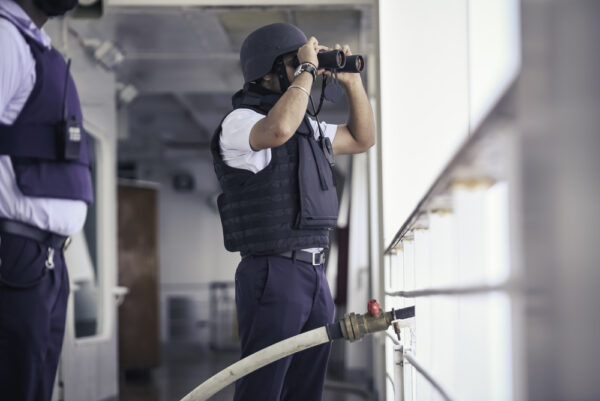Embarking on a cruise ship adventure with your family can be a thrilling yet daunting experience. The question, ‘Are cruise ships safe for my family?’ is one that many parents ponder. Keep reading to put your mind at ease!
Safety is deeply ingrained in the cruise experience. Cruise ships boast some of the lowest incident rates in travel, thanks to rigorous safety standards, regular inspections, and expertly trained staff. These floating resorts are equipped with life-saving equipment, adhere to stringent safety protocols, and feature the latest in safety technology, including state-of-the-art navigation systems and continuous crew training.
Cruise Ship Safety Regulations
Learning from past mistakes like the structure and lifeboat capacity that affected many lives on the RMS Titanic, technology and regulations are stricter than ever. All the best preventative, safety, and security measures are taken, including rigorous manufacturing regulations.
All cruise ships must have compartmentalized welded construction for flooding and fire containment, plus their bridge design must have all-around visibility.
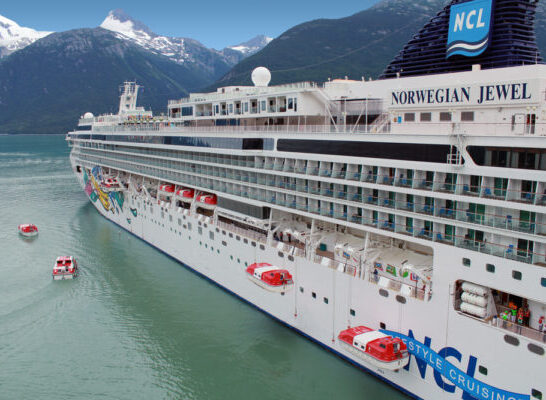
Here are the current regulations required by the Cruise Vessel Security and Safety Act:
- Echo sounder, ECDIS, AIS, and radar navigational aid.
- DGPS and precision position finding equipment and a Voyage Data Recorder.
- Satellite communication, GMDSS, and VHF.
- Emergency Position Indicating Radio Beacon (EPIRB).
- Lifeboats and rafts must be enclosed, and there must be enough for all crew and passengers plus extra.
- A life jacket and emergency immersion suites for every crew member and passenger.
- A weather forecast system that can track hurricanes, storms, iceberg locations, and their drift patterns.
- A helicopter pad for emergency evacuation and rescue services.
- A Public announcement system to communicate safety drills, emergency, and evacuation procedures.
- A resident doctor (physician) and a nurse.
All the crew undergo safety training, and passengers must do a safety and emergency evacuation drill before the ship embarks.
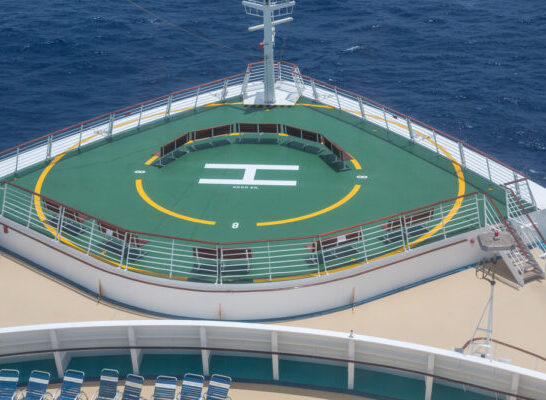
Safety Equipment And Technology Onboard Cruise Ships
Crew ships have strict guidelines and equipment that ensure passenger and crew safety in the case of an emergency. Safety equipment on cruise ships is essential and specifically designed to provide passengers and crew with the best possible chance in disaster strikes.
Here is a list of the safety equipment and technology typically found on cruise ships:
Lifeboats
When pondering the question, ‘What is the most crucial safety equipment on a cruise ship?’, lifeboats frequently emerge as the top answer. Integral to maritime safety, lifeboats are more than just a requirement; they are a lifeline in emergencies. Today’s lifeboats are a far cry from the simple dinghies of the past. These sophisticated safety vessels are not only enclosed, providing enhanced protection against the elements, but they are also equipped with essential survival tools, including provisions, first aid kits, and a small engine capable of sustaining operation for approximately 24 hours.
The adequacy of lifeboats extends beyond their mere presence. Factors such as their quantity, capacity, structural integrity, strategic placement, and ease of accessibility are critical components of a ship’s safety protocol. Each lifeboat is designed to meet stringent safety standards, ensuring it can withstand harsh maritime conditions. Rigorous testing and adherence to international safety and design regulations are mandatory before lifeboats are deemed sea-worthy.
Regular maintenance and inspection are cornerstone practices in the lifecycle of a lifeboat. Frequent drills and checks are conducted to guarantee their optimal functionality, ensuring that in the unlikely event of an emergency, these life-saving vessels are prepared to safely transport passengers and crew away from danger.

Life Rafts And Life Floats
Life rafts are a secondary means of life-saving equipment on cruise ships. Like lifeboats, life rafts are designed for emergencies in case the cruise ship is abandoned. Generally, life rafts are used by the crew in emergencies because they are not as big and comfortable as lifeboats.
Life rafts are inflated with carbon dioxide found in a storage cylinder packed inside the raft. Small cranes called davits lower life rafts into the sea after being inflated and boarded by the ship’s crew. Life rafts go through rigorous testing to ensure they hold up in case of an emergency and include:
- Drop test
- Jump test
- Weight test
- Towing test
- Damage test
- Inflation test
- Pressure test
- Seam strength test
All these tests are essential to ensure that the life raft can handle all the tough conditions and situations that may occur during an emergency.
Life floats offer an additional means of emergency support in the water. Life floats are typically open-topped and more simplistic in design compared to the enclosed structure of a lifeboat. They are designed to keep passengers afloat and out of the water.
Unlike lifeboats, life floats may not have propulsion systems or extensive survival equipment. They are equipped with basic safety features like grab lines, reflective material, and sometimes minimal survival gear.
The primary purpose of a life float is to provide immediate flotation assistance to people in the water, keeping them together and increasing their visibility for rescue.
Rescue Boats
A cruise ship may encounter another boat in distress or a passenger or crew member falling overboard. Although these are rare, cruise ships have rescue boats designed and designated for those emergencies.
Rescue boats vary in size, but they are mostly small and lightweight, and their main function is to rescue anyone in distress, tow a buoyant apparatus or life raft. Rescue boats are uniquely designed to remain stable during a rescue operation and are launched quickly from either side of the cruise ship.
Rescue boats are launched via davit because they are made from fiberglass, although they have buoyancy chambers to ensure stability. Like life rafts, rescue boats are subject to rigorous tests that include:
- Overload testing
- Operation testing
- Maneuverability testing
Life Preservers Or Personal Floatation Devices
Life jackets are essential to all crew and passengers’ safety, and they are tested for the following:
- Temperature cycling
- Buoyancy
- Fire resistance
- Stability
- Strength
Floating devices like life jackets are made from a reflective material to make spotting it easy, plus it is fitted with a light that aluminates once they come in contact with water. A whistle is fitted to the life jacket to get the attention of rescue personnel.
There are various types and sizes, either inflated orally, with carbon dioxide chambers, or a solid buoyancy life jacket fitted with foam.
Ring-Life Buoys
Ring-Life buoys are standard life-saving floating devices, and they are visible through cruise ships, especially at swimming pools and everywhere around the outer decks. Ring-Life buoys are the fastest way to aid anyone by quickly tossing it to a passenger who has fallen overboard or to someone in the swimming pool.
As per SOLAS regulations, the number of ring life buoys required for a cruise ship depends on size. So, for instance, cruise ships less than 200 feet must have 8 ring-life buoys, while ships longer than 780 feet require 30 ring-life buoys.
SOLAS requirements for ring-life buoys necessitate various specifications that include:
- It must withstand a free fall into the water from above the ship’s waterline or at least 98 feet without sustaining damage.
- A ring-life buoy must weigh a minimum of 5 1/2 pounds and be able to keep 32 pounds of iron afloat for 24 hours in freshwater.
Ring-life buoys go through rigorous tests, including:
- Temperature cycling test
- Drop test
- Oil resistance test
- Fire test,
- Floatation test
- Strength test
- Operational light and self-activating smoke signal tests
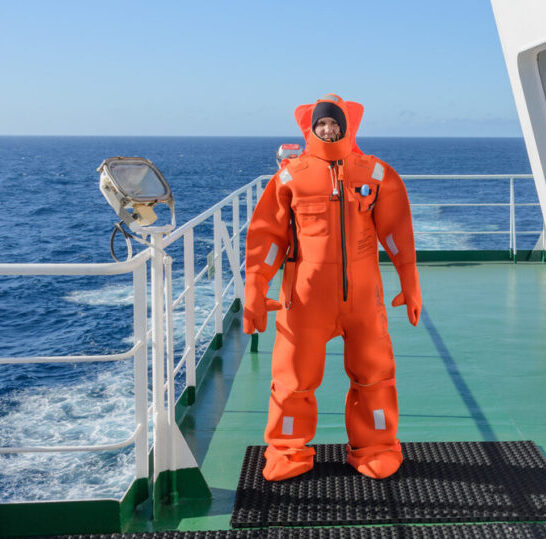
Survival Suits
When a cruise ship is in distress, and one crew or passengers finds themselves in the water, it is essential to know that the biggest threat is not drowning but hypothermia. (The Titanic incident provides such an example.)
Cruise ships have survival suits, also known as immersion suits, in the unlikely event that someone is in the waters.
Immersion suits are specifically designed to protect against hypothermia. These suits keep the body temperature from falling below 35 degrees Celsius inside the suit for at least six hours when exposed to water temperatures of 0 degrees Celsius.

Communication Systems
Communication on cruise ships is essential, especially regarding safety and emergencies. No communication or miscommunication can lead to chaos; communication becomes vital when thousands of people must be directed or informed.
Communication comes in various forms, including:
- Alarm system
- Public address system
- VHF radios (walkie-talkies)
If the cruise ship is abandoned, communication devices like walkie-talkies and loudspeaker systems are also installed in lifeboats.
Emergency Position Indicating Radio Beacons (EPIRB)
Finding a cruise ship in distress on the vast ocean requires special equipment. Rescue teams rely on radio signals, EPIRB (Emergency Position Indicating Radio Beacons), sent via satellite to pinpoint the cruise ship or lifeboat’s exact location. EPIRB are electronic devices that float and send coordinates like a GPS location.
Distress Signals
If you cannot see the ship or lifeboat, an Emergency Position Indicating Radio Beacon is helpful, but what if a nearby rescue vessel is not linked to the signal? Flares are essential once a rescue vessel like a helicopter or boat is near and in sight. Flares, commonly parachute flares, are used to signal any rescue party.
Red-colored Rocket parachute flares are used, and crew members are trained to shoot these flares and know how to and how many to shoot in an emergency. The flare draws attention to the distressed vessel’s location and is part of a lifeboat’s emergency equipment.
Are Cruise Ships Safe? Crew Training And Drills That Make It So
All crew members undergo drills and safety and security training supervised by a safety officer. Crew training is mandatory and happens before every departure. A pre-departure inspection includes walking with the safety officer through the ship, where safety systems, guest safety issues, and escape routes are identified.
Training includes:
- Ship Safety Orientation Training
- Security Awareness Training
- Personnel Nominated to Assist Passengers in an Emergency Training
- Pre-Departure Safety Training
- Crowd Management Training
- Safety observation
Crew members also get training in drills like:
- Fire Fighting
- Security Threats
- Search and Rescue
- Man Overboard
- Medical
- Chemical and Oil Spill
- Emergency Steering
- Damage Control
- Blackout Recovery
- Lifeboat Command
- Crowd Management
Crew are trained in all aspects of security and safety, and to execute it properly and successfully, they also get leadership, environmental policy, communication, and ethics training.
Common Safety Concerns And Prevention Measures During Cruise Travel
Everyday safety is essential on a cruise ship, and various prevention methods ensure it is safe for passengers. Like any hotel or resort, cruise ships have procedures, personnel, and equipment to handle a range of unexpected scenarios.
Common Illness And Disease Concerns
Cruise ships screen passengers for infectious diseases before they embark; this reduces potential health risks to other passengers. Outside of the COVID-19 pandemic era, the most commonly reported outbreaks on cruise ships have been GI illnesses such as the norovirus.
Potential cruise ship travelers can consult the CDC’s Travelers Health website for updated information regarding any health and outbreak specifics.
If a passenger shows any symptoms of a transmittable disease during the cruise. In that case, the ship may conduct a medical screening of all passengers and quarantine or isolate infected ones.
If the cruise ship has left port and you start showing possible symptoms, you should reach out to guest services and/or the medical center. If you call first, they can evaluate whether someone should come to your stateroom instead of you traveling through the ship to reach the medical center (and perhaps spreading something troubling).
The cruise ship’s medical staff will provide the necessary care and take preventative and health control measures if the situation requires it. The medical center is also responsible for reporting any potential public health risks.
Fire Safety
Being isolated far from the land makes cruise ships vulnerable to various safety hazards, and cruise ships take fire very seriously. Although fires are uncommon and mostly occur in the engine room, cruise ships have all the equipment and measures to ensure all passengers’ safety.
If a cruise ship has a 2700-passenger capacity, the vessel must have the following fire equipment in place:
- Fire marshals (five)
- Smoke detectors (4,000)
- Fire extinguishers (500)
- Sprinkler piping (16 miles)
- Sprinkler heads (5,000)
- Fire hose (six miles)
Maritime Crime
Crime is relatively low on cruise ships, and every possible measure is taken to ensure that passengers are safe. Cruise ships have security officers who handle theft, assault, and other crime-related acts and strive to keep everyone safe. On larger ships, the security personnel will often wear body cameras. Cruise ships also place cameras throughout public areas and elevators to identify persons and prevent crimes, violence, or erratic behavior.
Part of the Cruise Vessel Safety and Security Act requires that cruise ships entering or leaving U.S. ports must track reports of criminal activity and report crimes to the FBI. The Department of Transportation posts compilations of these quarterly incident reports on its website.
Cruise ships have various security measures, staff, and equipment, but like everywhere in the world, passengers also have some accountability. Passengers are warned not to accept drinks from strangers and to keep their cabins locked to ensure their belongings are safe.
Pirates
Many people think piracy is something of the ancient past, but it still happens today. There have not been any attacks on cruise ships by pirates in recent years. Cruise ships between Yemen and Somalia in the Arabian Sea, where piracy is still active, take steps to minimize a potential attack.

Cruise ships dim exterior lights when traveling in pirate-invested waters and ask passengers to dim cabin lights to minimize visibility. Extra security personnel accompany cruise ships if their route goes in or near areas where there could be a potential threat from pirates.
Ship Safety
A hundred years ago, cruise ships were the only and safest way to travel across the ocean, but today airplanes are commonly used, and cruise ships are more of a holiday experience. Everyone recalls the famous Titanic incident and wonders if it could happen again. Although cruise ship sinkings are rare, the sinking of the Titanic was not an isolated incident.
One beneficial result of the Titanic incident is that various measures were implemented after it sunk to ensure it never happened again. All cruise ships in America regularly undergo rigorous inspections by the U.S. Coast Guard to ensure it is safe. All cruise ships are subject to international SOLAS (Safety Of Life At Sea) rules regulating all navigation, safety, and maritime security.
Passenger Safety Briefings And Protocols
Before a cruise ship leaves its embarkation port, conducting a comprehensive safety briefing for all passengers is not just a routine but a mandatory practice. Cruise ships must conduct the safety briefing and muster drill so that every passenger understands the emergency procedures and knows how to respond effectively in various scenarios.
The relevant information may be communicated through some combination of video and life demonstration. Regardless of the precise communication methods, passengers are briefed on how to locate and use life jackets, identify muster stations, and the process of evacuation. By familiarizing passengers with these procedures, the aim is to ensure a well-organized and calm response, minimizing confusion and chaos in the rare event of an emergency.
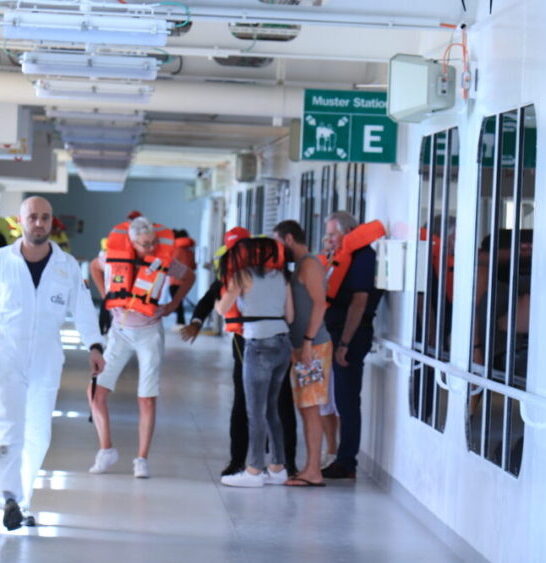
Cruise Muster Station And Muster Drill
The safety briefing onboard a crew ship starts with a muster drill. Muster means ” To assemble,” it happens when everybody onboard gathers for the safety drill and briefing, also called the muster drill. Muster drills are mandatory within 24 hours of boarding the crew ship, per the International Convention for the Safety of Life at Sea.
When the crew and passengers assemble for the safety protocols, the crew briefs everyone on what to do in the case of an emergency, which includes:
- The sound of the emergency alarm.
- Where to gather when the alarm is sound (meeting point), assembly points can include places like the theater that accommodate a large crowd, but it is mostly done out on deck.
- Where to get their life jackets and how to properly secure them.
- Nominated crew members in control at the station points.
- Taking the names of everyone that should be there.
- The procedures to follow for the various emergencies, including evacuation and various escape routes if necessary.
There are various other safety instructions included in the briefing that may not require all the crew and passengers to evacuate; these isolated incidents, like theft, medical emergencies, fights, etc., are also discussed during the safety brief.
The captain will mimic a nautical emergency once the safety protocols are explained to all the passengers. This simulation emergency allows passengers to familiarize themselves with the safety protocols. The simulation also provides the crew with the opportunity to identify anyone that needs better instruction.
The safety protocols and procedures are mandatory and include everyone regardless of age or disability. Many passengers have been on cruise ships before, have been through the safety protocols, and are not exempt from the muster drill, including the captain and all crew members.
Closing Thoughts
As you plan your next cruise, rest assured that your safety is the foundation of cruise operations. The diligence and expertise of highly trained crew members, combined with advanced safety technology and rigorous protocols, will seamlessly integrate safety into every aspect of your journey. So relax and leave your worries on shore!

